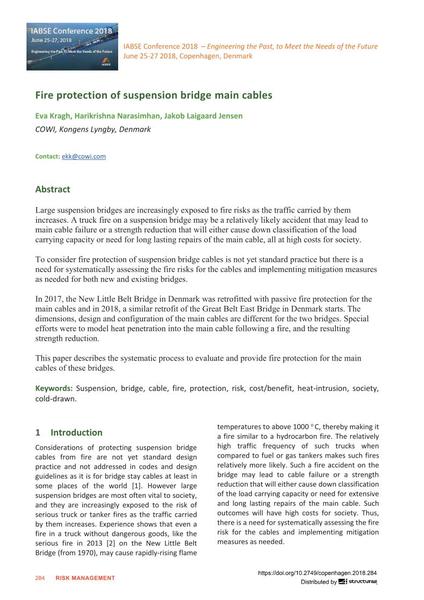Fire protection of suspension bridge main cables

|
|
|||||||||||
Bibliografische Angaben
| Autor(en): |
Eva Kragh
(COWI, Kongens Lyngby, Denmark)
Harikrishna Narasimhan (COWI, Kongens Lyngby, Denmark) Jakob Laigaard Jensen (COWI, Kongens Lyngby, Denmark) |
||||
|---|---|---|---|---|---|
| Medium: | Tagungsbeitrag | ||||
| Sprache(n): | Englisch | ||||
| Tagung: | IABSE Conference: Engineering the Past, to Meet the Needs of the Future, Copenhagen, Denmark, 25-27 June 2018 | ||||
| Veröffentlicht in: | IABSE Conference Copenhagen 2018 | ||||
|
|||||
| Seite(n): | 284-289 | ||||
| Anzahl der Seiten (im PDF): | 6 | ||||
| DOI: | 10.2749/copenhagen.2018.284 | ||||
| Abstrakt: |
Large suspension bridges are increasingly exposed to fire risks as the traffic carried by them increases. A truck fire on a suspension bridge may be a relatively likely accident that may lead to main cable failure or a strength reduction that will either cause down classification of the load carrying capacity or need for long lasting repairs of the main cable, all at high costs for society. To consider fire protection of suspension bridge cables is not yet standard practice but there is a need for systematically assessing the fire risks for the cables and implementing mitigation measures as needed for both new and existing bridges. In 2017, the New Little Belt Bridge in Denmark was retrofitted with passive fire protection for the main cables and in 2018, a similar retrofit of the Great Belt East Bridge in Denmark starts. The dimensions, design and configuration of the main cables are different for the two bridges. Special efforts were to model heat penetration into the main cable following a fire, and the resulting strength reduction. This paper describes the systematic process to evaluate and provide fire protection for the main cables of these bridges. |
||||
| Stichwörter: |
Brücke Seil Suspension Risiko Schutz Brand
|
||||

